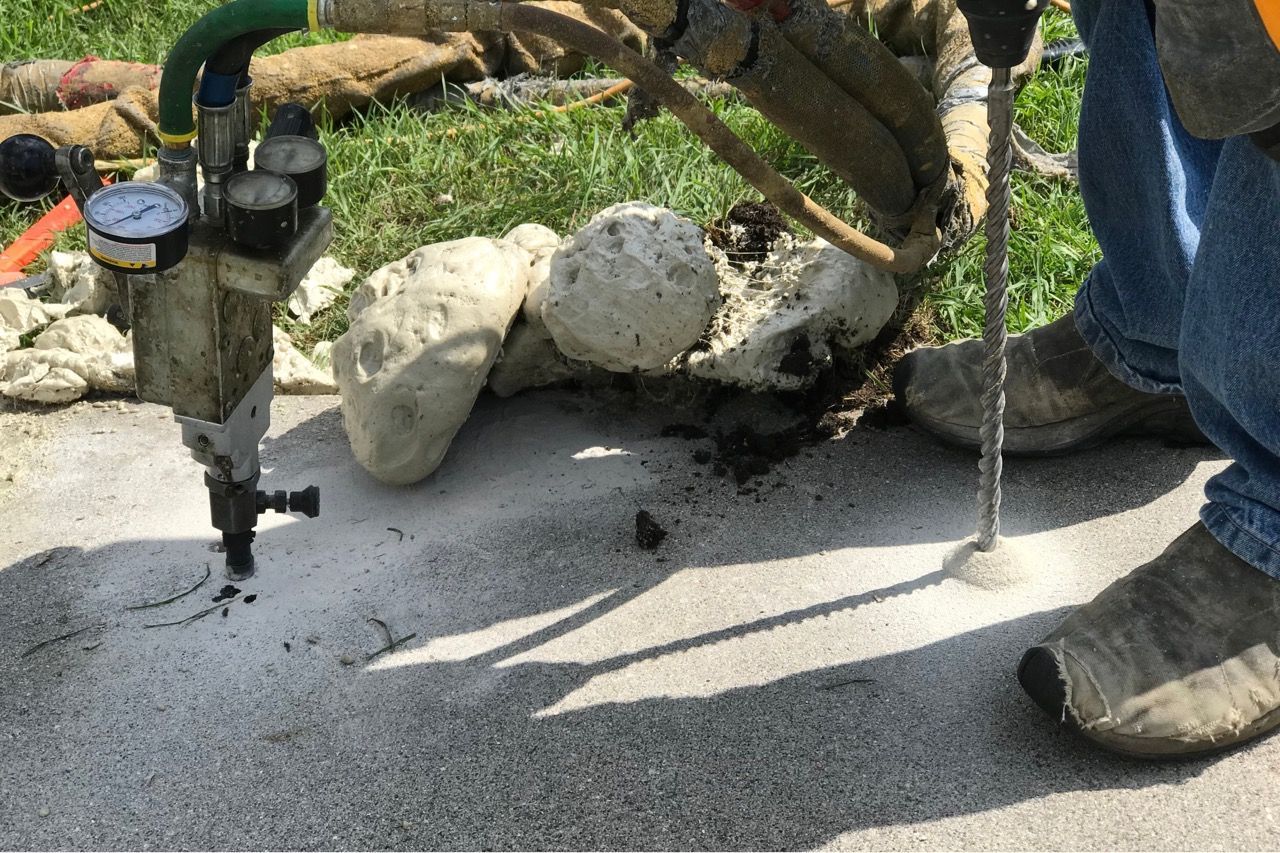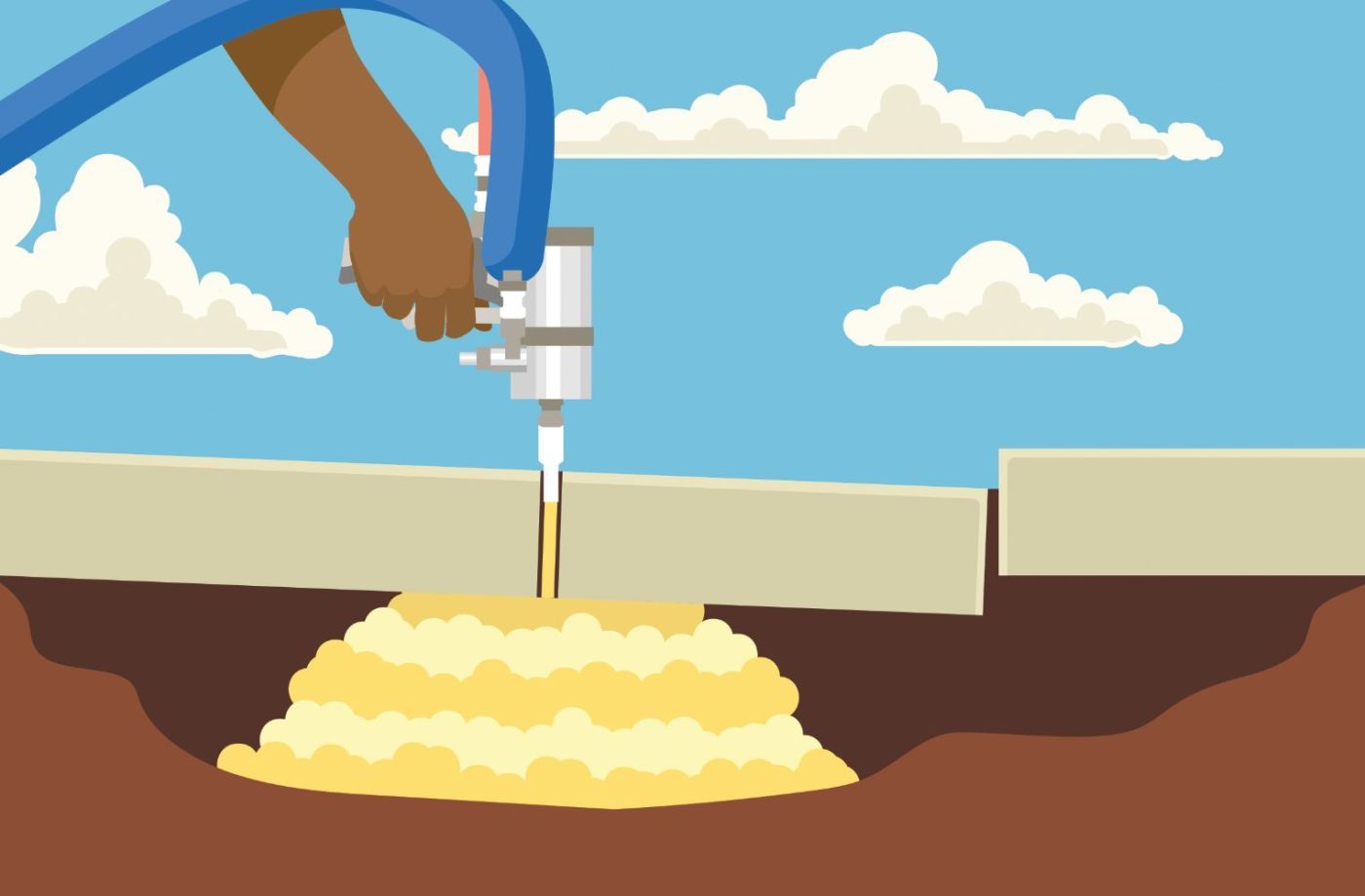
Get to the bottom of the most common myths about foam concrete leveling.
No matter how obvious the raised section in your front walkway is (or how obvious you make it with spraypaint), the tip of Grandma Nancy's shoe always finds a way to catch it.
Or maybe not having a lifeguard on duty is a pain with your little ones running and stubbing their toes on the settling concrete pool deck?
It could even be your sunken patio making backyard barbecues impossible – what’s a summer without hot dogs and hamburgers?
Whatever the problem you’re facing, you’ve ended up here: an article dedicated to shining some much-needed light on foam concrete leveling (also called polyjacking or poly leveling), a popular solution for issues like the ones listed above.
While researching your options and getting concrete leveling estimates, you’ve likely found what feels like a political campaign (and we have enough of those already): lots of big claims, mudslinging, and uncertainty over what the result will really be.
We offer polyjacking services at many A-1 locations, but we want to be as transparent as possible about what it can and can’t do. We will almost always suggest stone slurry grout leveling for most occasions, but completely understand when and where to use polyjacking – despite some of the busted myths you'll read below.
Our goal here at A-1 is to give you all the information you need to make informed decisions, not sell you a one-size-fits-all solution. For this reason, we’re busting both bad AND good myths (unfortunately without Adam Savage) about polyjacking that we frequently hear from concerned customers and read online ourselves.
Myth #1: Foam Reacts Chemically With the Soil
Claim:
When foam is injected under a settled slab, it penetrates into the soil and undergoes a chemical reaction that hardens the soil. This makes it so the soil can’t erode away or heave during freeze-thaw cycles.
Sounds great, right?
Busted:
Well, not quite.
The polyurethane concrete lifting foam is a two-part liquid before it’s injected under a settled concrete slab. A chemical reaction between the two parts is what makes the liquid expand into foam. This happens at the tip of the gun or nozzle, as soon as the two parts combine.
The only reaction that any form of professional concrete leveling (polyjacking, stone slurry grout leveling, or mudjacking) has with the surrounding soil is to compact and compress the soil downwards.
This physical pressure can help to minimize the chance of resettlement as it speeds up the natural compaction process, but it doesn’t mean that the leveling compound will permeate the soil and prevent it from moving.
Myth #2: Polyjacking Is Especially Great for Wet Conditions
Claim:
Because polyjacking foam is hydrophobic, it resists water and prevents the concrete from settling again.
Busted:
Even if the foam resists water, the soil underneath the polyjacking foam can still wash away and cause both the concrete and newly added foam to settle.
Also, because water does not easily pass through the foam, it could hold moisture against the bottom surface of the concrete. Excessive moisture in concrete can cause the slab to break down, especially in the winter months when freeze-thaw cycles are a big concern.
It’s also true that not all foams themselves are hydrophobic. Foams can be chemically designed for better tolerance against water, but all of them will absorb some amount of water.
Myth #3: Foam Is Lighter, So It Won’t Weigh Down the Soil
Claim:
Because concrete leveling foam is lightweight, it won’t weigh down the soil and cause the concrete to resettle, as opposed to the heavy materials used in stone slurry grout leveling or mudjacking.
This myth is a popular one. You’ll see it as a main selling point for using foam over anything else, but it just doesn’t hold up under pressure. (Pun intended)
Busted:
It doesn’t matter what material is used underneath a settling slab, light or heavy. If the soil has not completely settled before the concrete leveling repair takes place, it will likely settle again.
If the underlying soils have compacted fully before the leveling repair, regardless of the leveling method used to lift the concrete, the concrete could stay in place for the life of the slab itself without resettling.
While the weight of the concrete leveling method does not matter for the risk of resettling, erosion does. If the soil under the repair is washed away by runoff or a flowing downspout, or tunneled away by underground pests, you run the risk of resettlement.
Myth #4: Polyjacking is Clean and Mess-Free
Claim:
Foam concrete leveling is a clean and contained repair method, whereas stone slurry grout leveling and mudjacking get material everywhere and are hard to clean up.
Busted:
In reality, the foam used for polyjacking is sticky, stains, and can’t be simply washed off. Foam residues can only be completely removed by abrasive methods like grinding or sandblasting the concrete surface.
Additionally, foam that is left on the surface of the concrete will begin to yellow from exposure to the sun’s UV rays.
The stone slurry grout leveling and mudjacking compounds, on the other hand, can be easily washed off into your lawn with a hose. These all-natural and water-soluble materials aren’t dangerous to plants, animals, or humans.
Myth #5: Foam Better Fills the Voids Under Concrete
Claim:
Because of its expanding properties, foam spreads more and better fills the voids under settled concrete when compared to stone slurry grout leveling or mudjacking.
Busted:
Once injected beneath the concrete, the foam will spread well and fill voids. However, to ensure the foam does not over lift the concrete (because no one ever really knows how much space there actually is under a slab) and better control the lift itself, the foam material is injected in shorter spurts.
Because of this, small pyramids or “pancake stacks” can form where the foam was injected. This prevents the spread necessary to fully fill voids, which helps a concrete leveling repair last longer.

While the high pressure used in mudjacking also makes filling all voids tricky, stone slurry grout leveling uses lower pressure, slower pumping speed, and variable material thickness in order to fill all voids under the slab.
Myth #6: Polyjacking Is Stronger and Has Greater Lifting Power
Claim:
Polyjacking can lift more and support greater loads than mudjacking or stone slurry grout leveling.
Busted:
Generally speaking, foam concrete leveling is simply not as strong as stone slurry grout leveling or mudjacking.
Some of the stronger foams used in polyjacking have compressive strengths less than 100 PSI, whereas the stone slurry compound, without any strengthening additives, has a compressive strength of 200 PSI. It can get even stronger by adding compounds like Portland cement into the mixture.
While foam can be chemically designed to have different densities and strengths, the varying formula would require polyjacking technicians to invest in storing different material makeups. Also, switching from one chemical makeup to another can be a tedious and time-consuming process.
Myth #7: Polyjacking is Environmentally Friendly
Claim:
Polyjacking is more environmentally friendly than stone slurry grout leveling or mudjacking.
Busted:
While all concrete leveling methods are environmentally friendly in that they prevent concrete from going to landfills, polyjacking is generally the least environmentally friendly option.
Polyurethane foams are produced using chemicals derived from crude oil. Stone slurry grout leveling and mudjacking use all-natural products: soil, sand, and water for mudjacking, and limestone and water for stone slurry grout. (Our not-so-secret sauce)
Portland cement can be added to enhance the properties of these natural materials, which itself is not environmentally friendly as the process of creating it uses a lot of high heat, but it’s still made up of natural materials.
Your Next Steps
Whether it’s a front yard trip hazard, a poolside stubbed toe waiting to happen, or a very, very sad summer without firing up the grill, concrete leveling can likely solve the problem you’re facing.
Polyjacking is one way of going about it. It’s a widely used concrete leveling method that is great for many situations. But there’s a lot of misinformation surrounding its abilities.
Here at A-1 Concrete Leveling, we offer stone slurry grout leveling in all locations and polyjacking in some. But we want to paint the whole picture – not just the part that makes our services look good.
You should now know a little more about what polyjacking can and can’t do, but we recommend that you continue researching in order to learn more about all the concrete leveling options that are available to you.
Here you’ll find some related articles that talk about polyurethane foam leveling, stone slurry grout leveling, and mudjacking from our online concrete repair and maintenance resource library, Concrete Academy:
- All About Foam Concrete Leveling (Polyjacking)
- Foam Concrete Leveling: The Pros and Cons
- All About Stone Slurry Grout Leveling
- Stone Slurry Grout Leveling: The Pros and Cons
- What Is Mudjacking?
- Mudjacking: The Pros and Cons
If you’re ready to see what polyjacking or stone slurry grout leveling can do for your concrete, click the link below to request an onsite estimate with a member of the A-1 team!
Click Here to Find Your Nearest Location and Receive a FREE Estimate
Sarah Etler joined A-1 Concrete Leveling after receiving her Bachelor of Arts degree in English from Northern Kentucky University. As A-1's Content Marketing Manager, she works closely with industry experts to produce content that will best answer questions related to concrete repair and maintenance practices. Sarah loves living a life full of discovery and is excited every day to see what new things she can learn and share with those around her.
Topics: